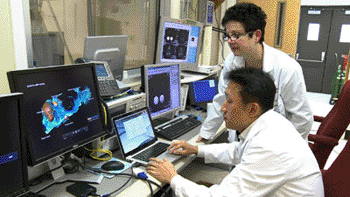MRI Captures Glympathic System in Rat Model
By LabMedica International staff writers
Posted on 06 Mar 2013
Magnetic resonance (MR) images are being studied in visualizing the glymphatic system in lab rats that had been given a fluorescent tracer. The whole brain images allowed the investigators to identify two major influx nodes in the brain. Moreover, they could measure the rate at which the fluorescent tracer was removed by the glymphatic system.Posted on 06 Mar 2013
The researchers, led by Helene Benveniste, MD, PhD, a professor in the departments of anesthesiology and radiology at Stony Brook University School of Medicine (Stony Brook, NY, USA), published their findings in the February 22, 2013, issue of the Journal of Clinical Investigation. In a companion commentary in the same issue, Dr. Warren Strittmatter of Duke University (Durham, NC, USA) discussed how this new technology could be used to track the development or progression of diseases in which the clearance of specific proteins is impaired.

Image: Helene Benveniste, MD, PhD, Professor in the Departments of Anesthesiology and Radiology at Stony Brook University School of Medicine, in her lab with a colleague (Photo courtesy of Stony Brook University).
Dr. Benveniste and colleagues built upon an earlier discovery by Jeffrey Iliff, PhD, and Maiken Nedergaard, MD, PhD, from University of Rochester (NY, USA), who first found and defined the glymphatic pathway, where cerebral spinal fluid (CSF) filters through the brain and exchanges with interstitial fluid (ISF) to clear waste, similar to the way lymphatic vessels clear waste from other organs of the body. In spite of the discovery of the glymphatic pathway, researchers could not see the brain wide flow of this pathway with earlier imaging modalities.
“Our experiments showed proof of concept that the glymphatic pathway function can be measured using a simple and clinically relevant imaging technique,” said Dr. Benveniste. “This technique provides a three-dimensional view of the glymphatic pathway that captures movement of waste and solutes in real time. This will help us to define the role of the pathway in clearing matter such as amyloid beta and tau proteins, which affect brain processes if they build up.”
Dr. Benveniste stated that the pathology of specific neurologic disorders is tied to the buildup of these proteins and other large extracellular aggregates. Specifically, she explained that plaque deposits of these proteins are implicated in the development of Alzheimer’s disease, as well as chronic traumatic encephalopathy that happens after repetitive mild traumatic brain injuries.
The researchers used contrast agents and molecular tracers with MRI to develop the imaging applications. Using these tools, they imaged major regions within the brain such as the cerebellum, orbitofrontal cortex, pineal gland, olfactory bulb, and nasal cavity, to map the entire glymphatic pathway. The contrast-enhanced images reveal the CSF-ISF interchange throughout the whole brain, including pathways in parallel to major arteries that are also involved in the glymphatic waste-clearing process.
The scientists suggested that this sophisticated imaging technique has the potential to be used as a way to monitor the human brain to map brain waste clearance and evaluate disease susceptibility. Dr. Benveniste stressed that, hypothetically, if clinicians were able to capture a defect in the glymphatic system where certain channels are breaking down, plaque formation would likely accelerate. This plaque accumulation may be an early sign of disease susceptibility before evidence of any cognitive changes. Although there is no known way to repair malfunctions in the glymphatic system, the investigators are examining ways to repair or open malfunctioning channels.
Related Links:
Stony Brook University School of Medicine
Duke University














